
The final stop on my trip was London, where I stayed for most of a week (thanks, Jakob and Sarah, for putting me up!) I had big plans, but ended up spending most of my time at British Library Newspapers doing research for an article. But first I got to spend a weekend looking at old aeroplanes, thanks to JDK who put me in touch with Trevor, who kindly offered his services as a chauffeur and guide. On the Saturday, we visited the fabled Shuttleworth Collection at Old Warden in Bedfordshire, which was holding an evening flying display.
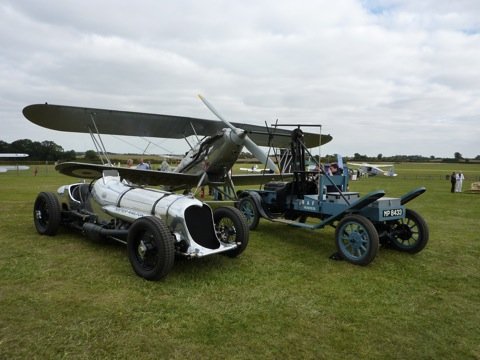
The collection consists of both vintage aeroplanes and vintage automobiles, nearly all from before the Second World War: here is a Hawker Demon interceptor, the Napier-Railton racing car (actually a visitor from Brooklands) and a 1920 Hucks starter.
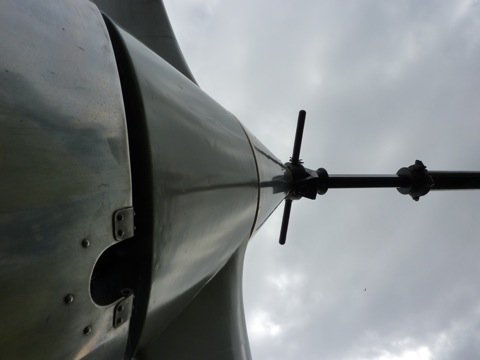
(The Hucks starter is used to start the propeller spinning, instead of doing it by hand. All the mod cons here.)
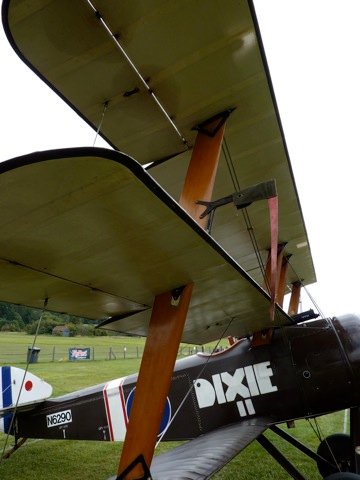
The wonderful thing about the Shuttleworth Collection is that so many of its aircraft can and do fly. (The cars can drive too, but I readily confess to being less interested in that.) This Sopwith Triplane can be seen in the air further down the page.
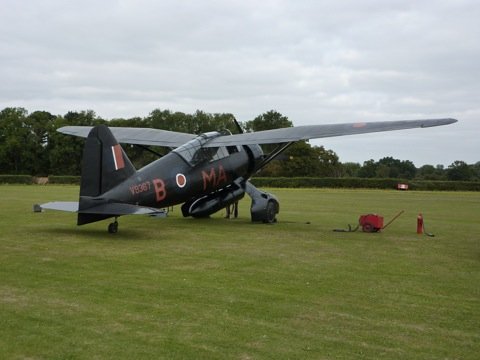
Well, they fly when they don't have mechanical difficulties, as with this Westland Lysander. A shame, as I was looking forward to seeing how it handled!

The other factor, of course, is the weather. On the day of my visit, it was overcast early on, but cleared up later on and by dusk the wind had fallen to the merest zephyr, which was perfect as it meant the 'Edwardians' would be able to fly.
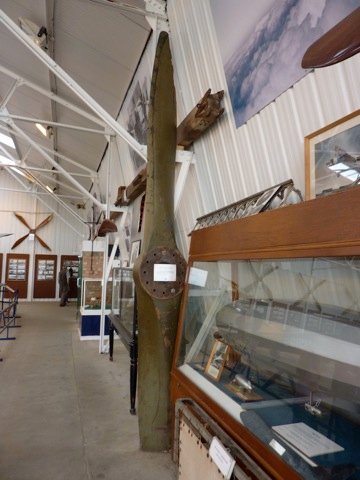
While the various machines were being moved around outside, I had a wander through the hangars. This is a propeller from the R101, damaged in a collision with the mooring mast at Cardington.
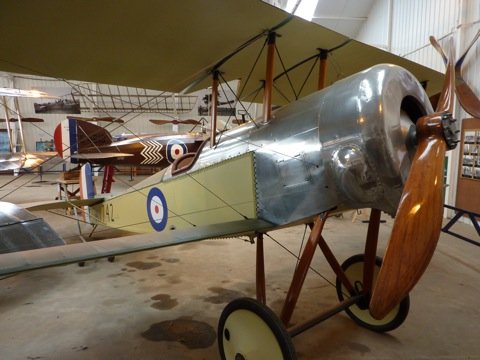
A Bristol Scout Type D replica, probably built by RAF apprentices in 1960.

One of the most historically significant aircraft in the collection, the de Havilland DH.88 Comet Grosvenor House which won the 1934 London-Melbourne air race. Say what you like about its almost-variable-pitch propellers, it's a gorgeous aeroplane.
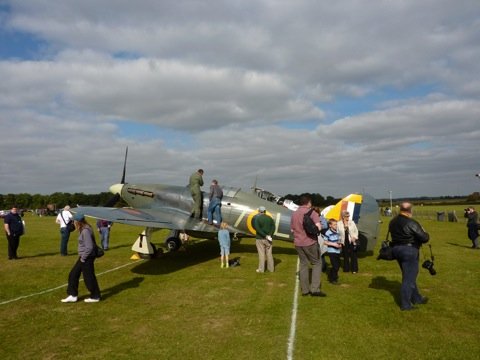
Back outside. One of the nice things about this display was that the flight-line was behind the rope, so you could get a good look at the aeroplanes and chat to the pilots. This Hawker Sea Hurricane IB was very popular.

A Blériot XI undergoing an engine check. (A replica -- I think. But see below.)
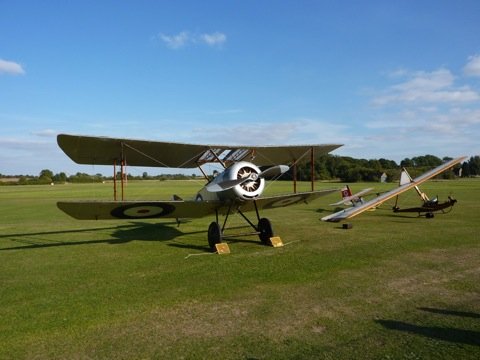
A Sopwith Pup and a German Schneider S.G.38 training glider, the one from the First World War, the other from the 1930s.
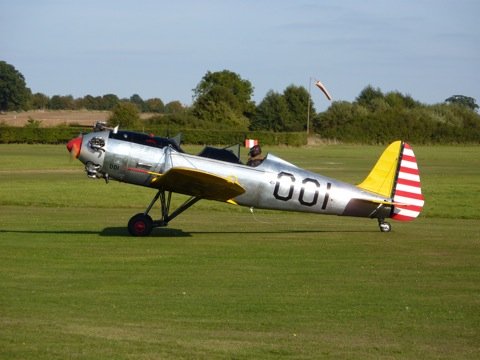
The primary trainer for the US Army in the Second World War, the Ryan PT-22 Recruit.
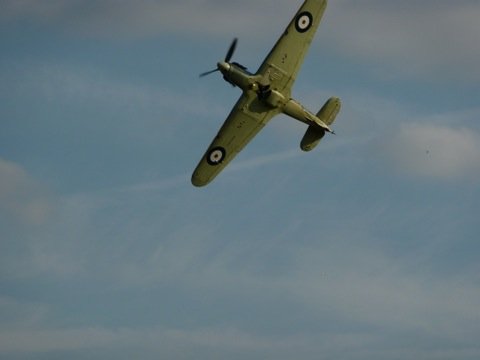
As I said, these things fly! This is the Sea Hurricane seen above. You might just be able to make out the fairing for the arrester hook, used for landing on the deck of a merchant aircraft carrier (i.e. a merchant ship fitted with a landing deck, to provide some air cover for convoys).

The RAF's last biplane interceptor, the Gloster Gladiator.

Spectacles require an audience.
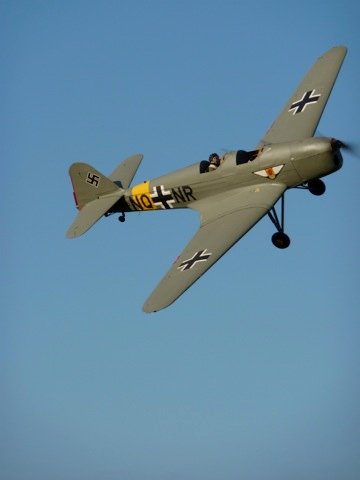
A Klemm Kl 35, a near-contemporary equivalent of the American PT-22.

Another trainer, the Bücker Bü 131 Jungmann, which equipped all the nicest air forces of the 1930s and 1940s: the Luftwaffe, the Japanese army, Franco's air force.

I think this was my favourite aeroplane of the day, the Avro Tutor, which is why it gets three photos (including the one at the start of the post).
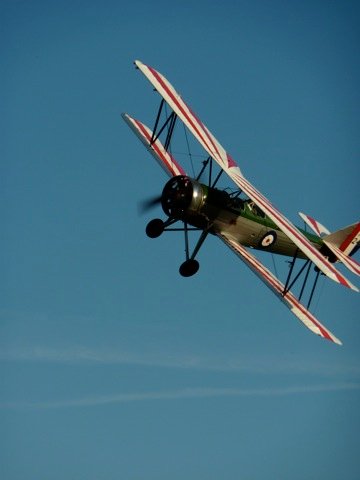
Photogenic and aerobatic.
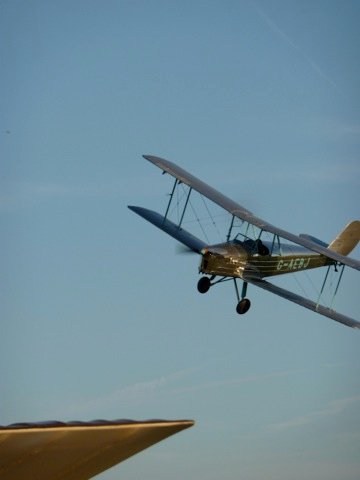
A very rare type: the only surviving Blackburn B-2, a side-by-side trainer. Only 42 were built, most of them used by civilian flying schools rather than the RAF.
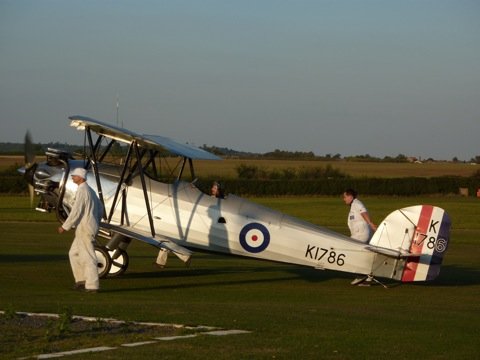
Another rare trainer, the Hawker Tomtit, which first flew in 1928. It lost out to the Tutor for a RAF contract, and only 35 were ever built.

As you may have guessed, the programme was ordered by reverse chronology. Now we're up to the late First World War (and the very late afternoon), with the Bristol F.2 Fighter, uninspiringly named but amazingly agile, especially given that its a two-seater.
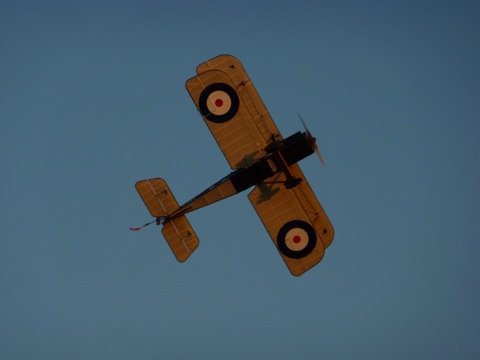
Probably the best British fighter of the war, the Royal Aircraft Factory S.E.5a.
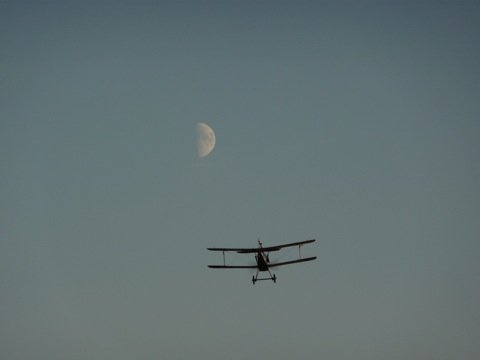
And it's a Great War veteran. 84 Squadron's CO was flying it when he shot down a Fokker D.VII on 10 November 1918.
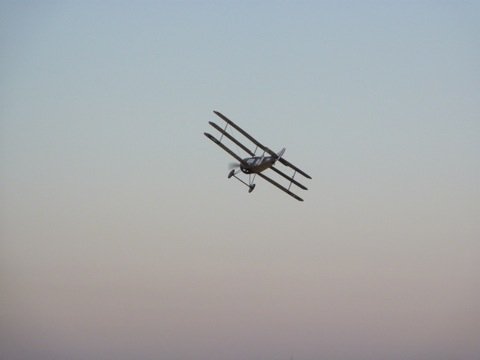
The Sopwith Triplane seen above. Only a reproduction, but one endorsed by Tom Sopwith himself.
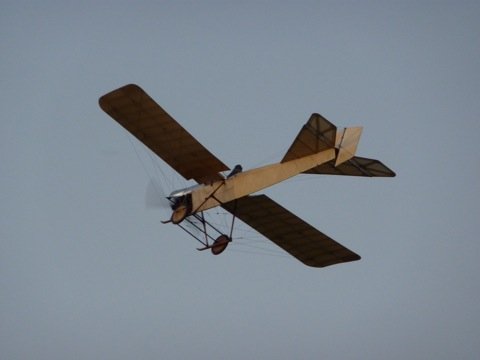
The oldest British aeroplane, the Blackburn Type D. The only one built, it first flew in late 1912, crashed on a farm in 1914, was recovered in 1938 and restored for its first flight in thirty-three years in 1947. And here it is, still flying, another sixty-three years further on!

A replica Bristol Boxkite, Britain's first military production aircraft.
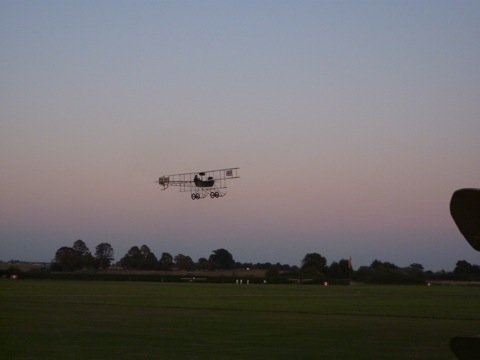
An Avro Triplane, another replica. This and the Boxkite were made for the 1965 film Those Magnificent Men in Their Flying Machines (which I watched on the A380 coming home -- first time I've ever seen an inflight movie with even one plane crash!) and the Shuttleworth got to keep them afterwards. The Triplane was flown by that bounder, Sir Percy Ware-Armitage.

And finally, the most amazing survivor in the collection, a Blériot XI built in 1909. It's the same type Louis Blériot himself used in his historic flight across the English Channel that year. It's the world's oldest aeroplane which is still flyable, and I got to see it fly! Of course, when I say 'fly', it really only hopped. It's too fragile to do turns -- especially given that it doesn't use ailerons to steer, but Wright-style wing-warping -- so all they did with it was get up enough speed to get into the air and then land again, turn it around and do the same thing in the other direction. But pretty amazing all the same. I was lucky that my camera's batteries just lasted long enough; between that and the low light my best photo of the Blériot gives a somewhat misleading impression of great speed. But it kinda works for me!
The Shuttleworth Collection is named in honour of Richard Shuttleworth, a rich kid who liked fast cars and aeroplanes, winning several motor races in the 1930s and even taking a course record from Sir Malcolm Campbell. But he also liked old cars and aeroplanes, and started collecting machines which even then were becoming rare. He joined the RAF and was killed in August 1940 while flying a Fairey Battle. His mother founded the Shuttleworth Collection (along with an agricultural college) in his memory, and we have cause to be grateful for them both for ensuring the survival of so many unique aircraft from the early days of flight.
![]() This work is licensed under a Creative Commons Attribution-NonCommercial-NoDerivatives 4.0 International License.
Permissions beyond the scope of this license may be available at http://airminded.org/copyright/.
This work is licensed under a Creative Commons Attribution-NonCommercial-NoDerivatives 4.0 International License.
Permissions beyond the scope of this license may be available at http://airminded.org/copyright/.

Erik Lund
The article in _Flight_ that introduces the Fairey Battle is headlined, "'Posterity will hear of these Battles!'"
Reading that made me sad, and it still does.
The article also has an under-the wing shot of a standing Battle. Those were _big_ planes for their engines.
Paul Gilster
Man, who knew there was still a flyable Gloster Gladiator! Not to mention that Blackburn Type D...
JDK
I’ve been looking forward to this one, wondering what you thought of it all!
Where to start? Well, with this – Many thanks to Trevor (TJJ) for coming through on a request from down under and providing a greater than normal entrée to certain venues!
The Shuttleworth Collection has one of the best airshow venues in the world, I think, but Brett doubly scored as this was the first time they’d tried allowing public access to the aircraft, normally the public and aircraft are separated by the flight line, as per most air events.
The Hawker Demon is a relatively recent restoration by Skysport Engineering, and has only been on the show circuit recently – I’ve not seen it fly! It doesn’t belong to the Collection, but they have a very similar Hawker Hind, which was recovered – by road – from Afghanistan in the 1970s. It’s currently having its rare RR Kestrel engine rebuilt.
For the puzzled, the Comet Racer as in the pictures has proper VP props fitted – the Ratiers were disposed of quickly after the air race on all the Comets, and you’ll note a tailwheel here rather than the original skid. It was restored to airworthy, and flew, but is currently grounded for a mixture of reasons – a pity in the 75th anniversary year of the race.
The ‘SG-38’ is actually a post-war British EoN Primary masquerading as a Nazi, but important as that’s where the Luftwaffe started – quite the acorn. (The Klemm and Bucker belong to Peter Holloway, a great supporter of the collection, who bases several of his aircraft there.)
The Collection’s Sea Hurricane (the only airworthy Sea Hurri) also has the catapult spools by the radiator and on the rear fuselage which enabled catapult launch – such as from the CAM Ships. It’s in the colours of a standard carrier aircraft rather than these more ‘exciting’ roles.
I have a special affection for this Gladiator. For many years it was the only airworthy example, but joined in the air in 2007 by the Fighter Collection of Duxford’s sister aircraft to this one. Shuttleworth’s was maintained before donation to the Collection by Glosters.
And here’s a pet pedant point of pernicketyness… As historians are supposed to ensure they say ‘the only example from the period we know of’, with airworthy aircraft my pet peeve is the ‘still flying’ epithet, implying regular dusting and the occasional engine oil change. There are no aircraft from before the 1950s flying that are ‘still flying’ – they all required a lot of restoration, conservation and disproportionate effort, obscure practical learning and cost to keep up there – an often misunderstood niche of social history cum mechanical engineering. For instance the current scheme is new since the Glad was ‘re-bagged’ (new fabric covering applied) in the early 21st Century. When the exhaust collector ring needs replacement, as has happened a couple of times in the last few decades for instance, it’s often a worldwide search to find a forgotten NOS (new old stock) example overlooked in a shed somewhere.
The Collection’s SE5a G-EBIA never actually saw service (non-original schemes often cause this kind of confusion) and was used postwar by Major J C Savage’s skywriting service with G-EBIB and G-EBIC (neat eh?) – all three of which survive, the other two in the RAF Museum and (restored to its original Skywriting configuration and colours) the Science Museum, London.
The Blackburn 1912 is one of my favourites in the collection, considering it’s remarkably ‘airworthy’ being structurally very similar to the Bleriot with identical control surface arrangements – including wing warping (but they all had different ‘control systems’ – no agreement on ‘stick & rudder’ back then) and weather permitting it potters around in big circles over the field for a while.
I hope Brett got to smell the Blackburn and the Triplane as these both have original rotary engines with castor oil lubrication. Nothing else sounds – or smells – like a genuine rotary. The Collection’s engineers have quite a challenge in engine configurations alone, running from two- and three-cylinder jobs through rotaries to the V-12 Merlins of the Hurricane and Spitfire. The Lysander’s perhaps temperamental Bristol Mercury is one of two in airworthy Lysanders worldwide currently (although there are more Lysanders to fly soon) and one of only four on airworthy aircraft – so with the Gladiator’s Mercury (quiet, isn’t it?) Brett’s seen half the world’s active Mercury population.
Last of all, with any luck, we’ll soon be able to get our blogger Brett to see the Project 2014 Bristol Boxkite replica under construction here in Victoria, to commemorate the centenary of the first military flight (at Point Cook). The Aussie one will have extended upper wings – making it bigger than the Shuttleworth replica – which enabled the carriage of ‘a military load’ i.e. a second person to the pilot equipped with a notebook and binoculars(!) See http://www.boxkite2014.org
Brett Holman
Post authorGack, I knew I was going to get something wrong in this post, and I did think that story about the S.E.5a was too good to be true. I even looked up G-EBIA on G-INFO but it doesn't have any information on its pre-civil origins. Of course it probably makes sense that frontline machines wouldn't show up as a war surplus -- who'd buy a used aeroplane when you could have a fresh one?
So the Shuttleworth's Hind is from Afghanistan? That would make it part of the Afghan air menace then.
Looking forward to seeing that Boxkite!
JDK
Sorry Brett,
Bad semi academic pun coming up...
That (air)field is my field! Grone.
(I also think I've got all the guides, books and listings the Shuttleworth Collection have published as well as many years of talking to the crews.) The Savage Skywriting story's an interesting one - even wrote over New York with SE5as!
Not only is the Shuttleworth's Hind an ex-Afghan example, so are the Canadian Aviation Museum's and RAF Museum's examples, as well as other survivors, while the RAFM and Shuttleworth's one (originally) appeared in Afghan colours. (The RAF Museum's Hind is at Cosford - the Harts are at Hendon). A couple of years ago another cache of Hawker bits - frames, wing parts and identities - was found there and brought back and we should see more Hart family members restored and some fly.
G-INFO's good for owner details, but not much chop for the histories. The Shuttleworth website's aircraft histories are mostly accurate now. Ray Rimmell's W.W.I Survivors (Aston) is probably the best book on the period, but isn't perfect and Ray took actual examples, not types, as his subject, frustratingly. Post 1918 machines are often briefly dismissed.
And while I remember, the Aussie Boxkite replica project will be on show at the forthcoming RAAF Museum Pageant on Feb 28 (plug) details on the RAAF Museum's website.
http://www.airforce.gov.au/RAAFMuseum/
Be there or be unairminded?
Chris Williams
Ta for pics and report, Brett, and ta for the comments, JDK. I used to go to the Shuttleworth Collection once in while as a child. I remember it as cold. Really, really cold inside.
JDK
Ah, the 'why they don't have airshows in the UK winter' effect.
Give it another go in the summer, Chris, whichever year you get one.
More seriously, the Shuttleworth Collection is one of the most important collections of aircraft - as they fly, and are original in construction and engines, in almost all cases, and unlike many others. They therefore perform as originals as far as is safely reasonable. You don't see an Avro 504 looped anywhere else.
As well as being a good day out, actually experiencing the real thing in action is worth a packet of armchair theorising. They also provide a core of real, practical tested data on how to build, maintain and fly these types. They deserve our support for that.
Flying days are a full day's airshow once a month on Summer Sundays and alternating with flying evenings on a Saturday afternoon in the same period.
Mrs JDK and I built our last around-the-world trip on two Old Warden dates. Don't miss them!
Ian Evans
After being kept off the site for too long by a new censorship program at work I feel a burst of ubergeekery coming on (sorry, clean out of umlauts). What's the animus againt Ratier props? Is it because they is French?
In fact the first Comet to fly 'CSP/E1 did so with Hamilton Standard propellers; they were rejected because of weight, complications and development time required (DH 88, Ogilvie D. pub Airlife 1984/1988, incudes pictures of the installation). It's also not correct to say they were discarded immediately after the race, 'CSR still had Ratiers in December '34 for a mail flight to the (then) Belgian Congo (another photo in Ogivie), and 'CSP, when in Portuguese markings as CS-AAJ in 1935 had them too. Ironically, F-ANPZ, built for the French government did have Hamilton Standard units, while the last Comet built, 'DEF (July '35) had Ratiers.
'CSS retained Ratiers throughout her RAF service, and they weren't replaced until 1937 when Clouston ( (The Dangerous Skies, Clouston A. E., Pan Books 1956) had Gypsy VI engines fitted, and he included Hydramatic propellers, still only two position though.
Hope this quoting of sources doesn't imperil my amateur status.
JDK
Fair call on the replacement dates on the Ratier props, apologies! No animus against Ratier - nor French material. But I'd bet you couldn't certify them today, and I'd not fly in a twin so equipped. Just look up how they worked.
Ian Evans
Point was that the Ratier was the best choice available for that particular application at the time, and its disadvantages didn't demand immediate replacement. Think of it as flying Derailleur gear perhaps "c'est brutale, mais ca marche".
Yes, ther's no chance of it meeting modern standards (but even now variable pitch props get certification problems). Suspect the major difficulty would be with the bicycle pump.
JDK
Ian,
Some fair comment there, but more to be said. I've found my notes and some refs, plus a photo of a Ratier fitted to the Gypsy at Old Warden, so I'll post all that on my blog next week, DV. This weekend I've some real aeroplanes to play with at the RAAF Museum's Pageant (plugette, see Brett's Twitter link). In the meantime, I can't think of a VP prop type (as in mechanism, rather than brand) that isn't (or hasn't been) active on a vintage aircraft somewhere in the world. Can you suggest one?
Regards,
Pingback:
Airminded · Duxford and North Weald
Ian Evans
Quite a challenge, given the limited number of ways of actuating a variable pitch propeller. How about the Manual Variable Pitch propeller that was fitted to a Gipsy Major (and I think flew in a Chipmunk)? That had the pilot winding a handle round and round to change pitch.
At a different scale, are there any Curtiss Electric propellers still flying - at least with the control boxes full of valves (alias vacuum tubes)?
Pingback:
Paris | Airminded